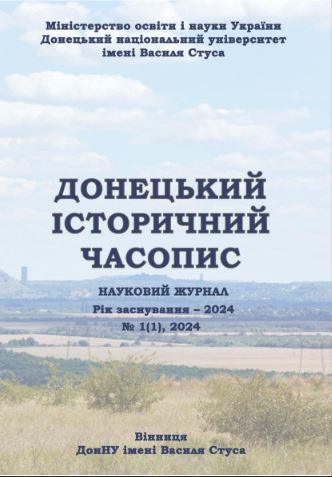Ukrainian soviet detectives and emigration sensational stories (1920s–1930s)
DOI:
https://doi.org/10.31558/3083-5771.2024.1.5Keywords:
detective story, sensational stories, the period between the two world wars, soviet reader, emigrant reader, everyday historyAbstract
The study of ukrainian soviet and emigration literary tastes, which changed under the pressure of historical realities in the 1920s and 1930s. Distinguishing the concepts of «ukrainian soviet detective story» and «ukrainian emigration sensational stories».
Methodology of research is based on the principles of historicism, objectivity, comprehensiveness, integrity, systematicity, as well as on the use of methods of analysis and synthesis, historical-genetic, historical-comparative, historically-typological, problem-chronological.
It was found out that the soviet detective by Volodymyr Vynnychenko, Dmytro Buzko, Georgy Danylovych, and Yuri Smolych prevailed in the 1920s. There were many autobiographical allusions in the storylines of the soviet detective. The Vynnychenko novel «Gold Deposits» sparked interest due to the mysterious fraudulent schemes of the characters, which reflected the corruption of the Directory period. In the story «Lyolya» by Dmytro Buzko, the author’s repatriation and his undisguised desire to settle scores with those involved in the «supruniada» it was read. «Provocateur» by Georgy Danylovych was the first attempt in such a literary genre as a classic detective story. Yuri Smolych intrigued with espionage (the detective story «One and a Half Men») and fiction (the detective story «The Household of Doctor Galvanescu»).
In the 1930s, party ideologistses cunning bullet targeted the soviet ukrainian detective, which caused a lot of trouble for Yuri Shovkoplyas with his doctor Piddubny, because there could not possibly be any maniacs, rapists, or thieves of socialist property or any criminal domestic plots in a soviet detective story.
Instead, the 1930s were the years of emigration sensational novels. At that time, Ukrainian immigrants on the European continent enjoyed reading the works of Hryhoriy Luzhytskyi, who «did not invent the bicycle», but continued to promote the glorious Ukrainian past, adding new Ukrainian heroes to it – the most ordinary emigrants, fighters, detectives. Among his sensational stories, the most famous are: «The First Night» (1928), «Comrades of the Smile» (1929), «The Room with One Entrance» (1931), «The Clock with the Broken Glass» (1933), «Shot in the Night» (1934), «Hallo!.. Hallo!.. Attack on the bank!» (1935); trilogy «Crimson Cross» (1931–1937).
Reading books by ukrainians as a psychological release and relief from stressful situations on both sides of the border during the period between the two world wars is the clear example of practicality and intellectual satisfaction, which is so important in our time. The study of the literary preferences of ukrainian soviet readers and ukrainian emigrants in the 1920s and 1930s as recreation is promising from the perspective of such a scientific direction as everyday history, which examines the conditions of life, work and rest, as well as factors affecting the formation of consciousness and norms of behaviour, socio-political preferences, etc. of the vast majority of the population («ordinary people», «nameless», «silent») of one or another country in one or another historical period.
References
Buzko, D. (n. d.) Lolia [Lolya]. Retrieved from https://www.ukrlib.com.ua/books/ printit.php?tid=17648 (data zvernennia: 14.07.2022) [in Ukrainian].
Hai-Nyzhnyk, P. (n. d.). Koruptsiia sto rokiv tomu: yak obkradaly armiiu UNR i do choho tse pryzvelo [Corruption a hundred years ago: how the army of the Ukrainian Peopleʼs Republic was robbed and what it led to]. Retrieved from https://rozmova.wordpress.com/ 2019/04/01/pavlo-hai-nyzhnyk/ (data zvernennia: 12.05.2019) [in Ukrainian].
Hai-Nyzhnyk, P. (2010). «Supruniada»: uriad Dyrektorii proty Finansovoi ahentury UNR v Nimechchyni (1919–1921 rr.) [«Supruniad»: the Government of the Directory against the Financial Agency of the Ukrainian Peopleʼs Republic in Germany (1919–1921)]. Kyivska starovyna – Kyiv antiquity, (1), 46–70 [in Ukrainian].
Kuznetsov, Yu. (1990). Detektyv: zanepad chy rozkvit [The detective: decline or prosperity]. Vsesvit – Universet, (10), 156–161 [in Ukrainian].
Polianych, B. (1974). Stril unochi [Shot at night]. Filiadelfiia. Vydavnytstvo: Konotop [in Ukrainian].
Smolych, Yu. (n. d.). Hospodarstvo doktora Halvanesku [The farm of Dr. Galvanescu]. Retrieved from https://knigoed.club/page-14-4573-gospodarstvo-doktora-galvanesku-jurij-kornijovich-smolich.html (data zvernennia: 12.05.2019) [in Ukrainian].
Syrota, L. (n. d.). Luzhnytskyi Hryhir [Luzhnytskii Grigor]. Entsyklopediia suchasnoi Ukrainy. Retrieved from https://esu.com.ua/article-59059 (data zvernennia 14.06.2023) [in Ukrainian].
Tsymbal, Ya. (n. d.). Korol na choli revoliutsii: Heo Shkurupii u futopreriiakh [The king at the head of the revolution: Geo Shkurupii in the foot prairies]. Lokalna istoriia. Retrieved from https://localhistory.org.ua/texts/statti/korol-na-choli-revoliutsiyi-geo-shkurupii-u-futuropreriiakh/ (data zvernennia: 24.03.2024) [in Ukrainian].
Tsymbal, Ya. (2019). Narodzhennia ukrainskoho Kholmsa. Postril na skhodakh. Detektyv 20-kh rokiv [Birth of Ukrainian Holmes. Shot on the stairs. Detective of the 20s]. Kyiv: Tempora [in Ukrainian].
Tsymbal, Yа. (n. d.). Shkurupii. Vid A do Ya [Shkurupii: From A to Z]. Ukrainskyi tyzhden. Retrieved from https://tyzhden.ua/shkurupij-vid-a-do-ia/ (data zvernennia: 12.05.2019) [in Ukrainian].
Vesheleni, O. (2013). Zhanr «sensatsiinoi povisti» v ukrainskii emihratsiinii literature [Genre of «sensational story» in Ukrainian emigration literature]. Pytannia literaturoznavstva – The issue of literary studies. Zbirnyk naukovykh prats. Chernivetskyi natsionalnyi universytet im. Yu. Fedkovycha, (87), 311–321 [in Ukrainian].
Vynnychenko, V. (n. d.). Poklady zolota [Deposit gold]. Biblioteka ukrainskoi literatury. Retrieved from https://www.ukrlib.com.ua/books/printit.php?tid=10412 (data zvernennia: 14.02.2024) [in Ukrainian].
Vivcharyk, N. (1996). Hryhor Luzhnytskyi: mytets, yakyi nazavzhdy zalyshyvsia ukraintsem [Hryhor Luzhnytskyi: an artist who forever remained Ukrainian]. Zbirnyk prats i materiialiv na poshanu Hryhoriia Luzhnytskoho (1903–1990). Zapysky NTSh: Pratsi filololohichnoi sektsii. Lviv; Niu-Iork; Paryzh; Sidnei; Toronto, (12) [in Ukrainian].

